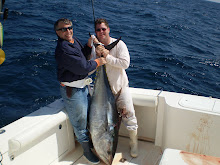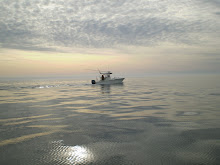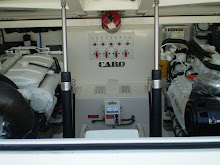 By Jim Field
By Jim FieldToday I am formally undertaking a 2010 initiative to find and acquire a new boat. (Let's see how long it takes for Diane, my wife, to pick up on this.) Don't get me wrong, I love my Cabo 35, and would be more than happy to own it for the remainder of my fishing days. But that said, change is good in life; a challenge is good in life; and every once in a while you have to mix things up. At least, that's what I'm thinking (I don't assume every reader will agree, if you get my gist). But what the hell, sometimes it's just time to do something different. Okay, radically different.
Five years into fishing now, and owning and running a boat, and looking at other boats doing the same thing, what I've come to realize is that bigger is better, up to a point, for a host of different reasons that we should all know and appreciate. Also, as with other high-ticket items, new boat prices have a huge built-in premium, which for most of us translates into a smaller boat for what we can afford to shell out.
Alternatively, one can find used boats of a good length for a reasonable amount of money. The equation: affordable length is inversely proportional to age of boat. Also, as I understand now, and only with the benefit of time on the water, if you wish to pursue sportfishing seriously, there are some incredibly cool boats out there for doing this--particularlt custom Carolina-design boats that, for me, set the mark. Period; say no more.
We see these boats down south, and we consider them to be the ultimate fishing machines. We fantasize about fishing on one. Sure, we say, maybe in another life. Well maybe so....but today I'm going to start down the path of looking for one, and see how it goes. Maybe it doesn't work out. Maybe it does. We'll just have to go for it, and see what happens. Better to be in the game than on the sidelines. May fair winds prevail.
Here's what I'm after for an upgrade: (none of the criteria are negotiable)
- a
working sportfishing boat, which may or may not look "shiney"
- length at waterline >45 feet
- between 10 and 15 years old
- price <$450,000 (ideally <$400,000)
- custom-built in North Carolina
- mechanically rock solid
That's the sum of it. Sounds straighforward, right? Also, it's got to be a contingency sale, i.e., I have to sell mu current boat before moving into the new one. So a double-deal necessary.
I'm currently working with a
very motivated broker in North Carolina. Yesterday he sent me a few boats that he thought met my crtieria and he wanted me to look at. I've posted their photos below.
54' Jarrett Bay Sport Fisherman
• Year: 2000
• Current Price: US$ 359,000 (10/09)
• Located in Atlantic Beach, NC
• Hull Material: Composite
• Engine/Fuel Type: Twin Diesel
• YW# 1842-1816150  47' Buddy Davis Convertible
47' Buddy Davis Convertible
Year: 1996
Current Price: US$ 419,000
Located In Fort Lauderdale, FL
Hull Material: Fiberglass
Engine/Fuel Type: Twin Diesel
YW# 1359-1807787 





















